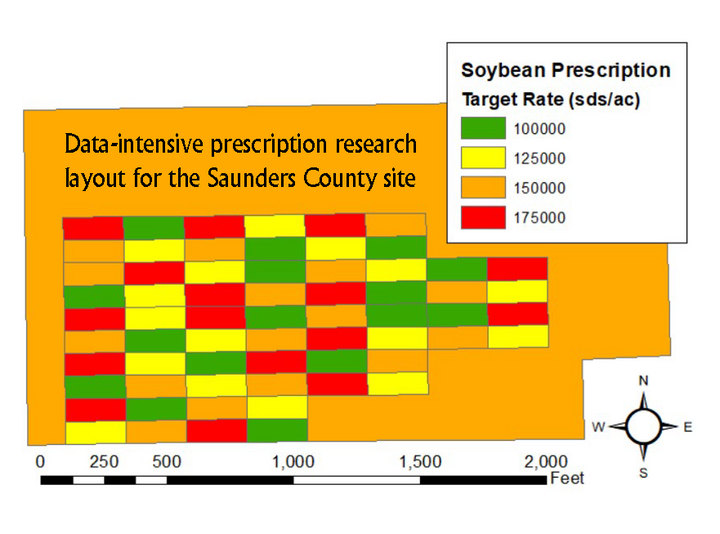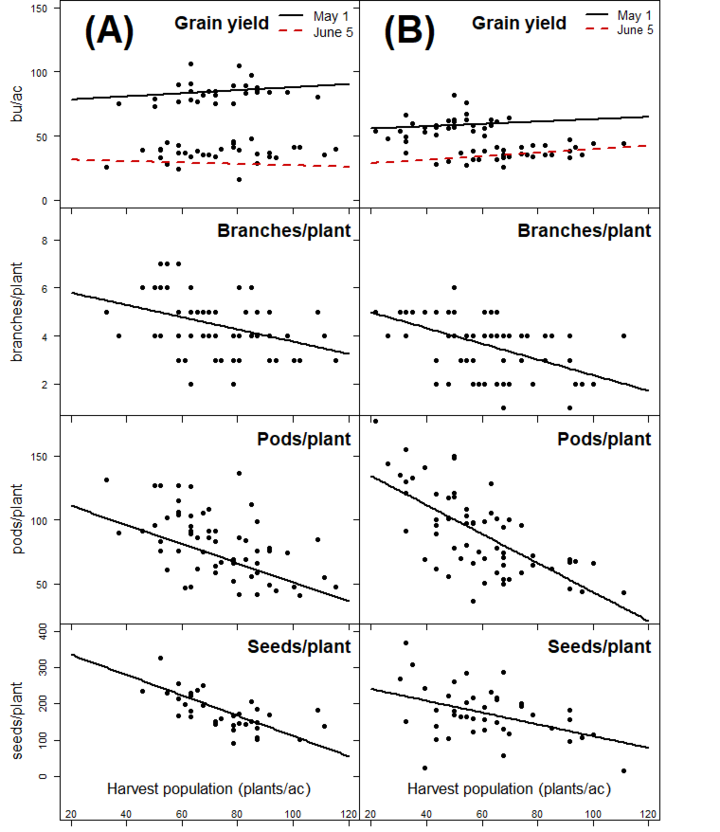While soybean seeding rates are not as critical to soybean yield as other factors such as genetics and planting date, questions regarding the agronomic and economical soybean seeding rate continue to surface. There is much data from Nebraska Extension and other Midwestern universities regarding these questions with the general theme that soybean seeding rates can be reduced without significantly impacting yield.
Key Points
- Nebraska On-Farm Research data from eastern Nebraska and western Nebraska for 12 years of combined data showed only a 0.6 bu/ac yield increase when seeding 180,000 soybean seeds/acre compared to 120,000 seeds/acre in 15-inch or 30-inch rows. (No studies in sandy soils).
- Soybean seeding rates of 90,000 to 120,000 seeds/acre resulted in the highest profitability.
- Two Nebraska On-Farm Research data-intensive management studies in 2018 showed no statistical yield difference in seeding rates from 100,000 seeds/acre to 175,000 seeds/acre with the highest profitability at 100,000-125,000 seeds/acre.
- Our studies did not adjust for seed germination as each seed lot had at least 90% germination. With lower seed germination expected this year, if seeding less than 150,000 seeds/acre, we’d recommend factoring in the germination percentage. If seeding 150,000 seeds/acre or more with an 80-98% germination, based on our research we don’t recommend increasing the seeding rate as there’s already enough seed.
Recommendations
- Based on our data, consider seeding 120,000 seeds/acre and aim for a final plant stand of 100,000 plants/acre. Dropping your seeding rate from 150,000 seeds/acre to 120,000 seeds/acre could save $10.08/ac. This accounts for a potential yield loss of 0.3 bu/ac and a savings of $12.86/acre on seed (assuming seed cost $60/140,000 seeds).
- For those currently planting 160,000 seeds/acre or more, consider reducing rates to 140,000 seeds/acre this year as a step-wise approach to reducing seeding rates.
Similar Recommendations from Other States
Iowa State recommends seeding rates of 125,000-140,000 seeds/acre for both 15-inch and 30-inch planted row spacings. Purdue recommends seeding rates of just over 130,000 for 30-inch row spacing. The University of Wisconsin recommends planting less than 140,000 seeds/acre in white mold areas, targeting a final stand of 100,000+ plants in productive fields, and targeting a final stand of 135,000+ in low productivity fields or areas within fields.

Seeding Rate Prescriptions
With precision agriculture technology, there’s been interest beyond traditional on-farm research strips to look at field variability with more data-intensive plots. Prescriptions can be written in various ways such as using zones for the purpose of variable rates or a more data-intensive layout with smaller replicated areas (Figure 1). Two data-intensive studies were conducted in Nebraska in 2018 with Joe Luck, extension precision agriculture specialist. The treatments were replicated and randomized in 90-by-240-foot blocks across entire fields.
The results showed no significant yield difference in seeding rates from 100,000 seeds/acre to 175,000 seeds/acre with highest profitability at 100,000-125,000 seeds/acre (Table 1). Additional studies are being conducted in 2019.
| Seeding rate (seeds/acre) |
Saunders County | Cass County 8 replications Pivot irrigated but no applications | ||||
|---|---|---|---|---|---|---|
| Yield (bu/ac) | Marginal Net Return ($/ac) | Yield (bu/ac) | Marginal Net Return ($/ac) | |||
| 100,000 | 65 A* | $441.78 A | 51 A | $340.56 AB | ||
| 125,000 | 64 AB | $425.51 A | 54 A | $346.52 A | ||
| 150,000 | 62 B | $398.85 B | 53 A | $331.10 AB | ||
| 175,000 | 63 AB | $395.54 B | 52 A | $318.60 B | ||
| *Values with the same letter are not significantly different at a 90% confidence level. Yield values are from cleaned yield monitor data. Bushels per acre corrected to 13% moisture. Marginal net return based on $7.40/bu soybean and $55/unit of soybean seed. |
||||||
Why Seeding Rate Matters Less than Other Factors

Lack of soybean yield response to increasing populations may be explained by increased competition among the soybean plants themselves. Increasing plant population causes individual soybean plants to produce fewer branches, pods, and seeds, and consequently less yield. This has been documented in both eastern and western Nebraska on-farm research studies in addition to others.
For example, soybean yield at both the Kemling and Stumpf farms (both in Perkins County) did not respond to changes in plant populations. Although soybeans were seeded at 90,000 and 140,000 live seeds/ac, actual harvest population (plants/ac) ranged from 30,000 to 120,000 plants/ac at the Kemling Farm and from 20,000 to 110,000 plants/ac at the Stumpf Farm. The stand reduction at both sites was due to early season crusting issues and hail injury (Figure 2).
The increased branching also aids in canopy closure and, to date, we haven’t observed differences in weed control with different seeding rates based on photos and NDVI imagery. There are also observations from Extension and agricultural industry professionals that reducing soybean populations led to thicker stems which led to less lodging by dectes stem borer. Our goal is to better document this in 2019.
Test for Yourself
Consider trying this yourself for your location. Consider using either this Two Population Treatment Design or Four Population Treatment Design. For data-intensive soybean prescriptions, please contact Joe Luck. If you have questions or need help setting up your research project, please contact your local Extension educator or anyone involved in our Nebraska On-Farm Research Network.
References
Conley, Shawn P. and Damon Smith. The Soybean Seeding Rate Conundrum.
De Bruin, Jason and Palle Pederson. 2008. Soybean seed yield response to planting date and seeding rate in the upper Midwest. Agronomy Journal. 100:696-673.
Gaspar, Adam P. January 2019. Soybean Seeding Rate - Past, Present, and VRS Future.
Licht, Mark. Soybean Plant Population.
Rees, Jenny, Laura Thompson, Nathan Mueller. April 2018. What On-Farm Research has Taught Us about Soybean Seeding Rates.
Rees, Jenny, Laura Thompson, Keith Glewen, Gary Zoubek, Nathan Mueller. March 2017. 10 Years of Research Shows Benefit of Reducing Soybean Seeding Rates.
Stepanovic, Strahinja, Nemanja Arsenijevic, and Zaim Ugljic. December 2018. Seeding Practices and Nitrogen Management for Western Nebraska Soybean: What Matters and Why.
